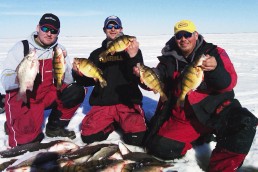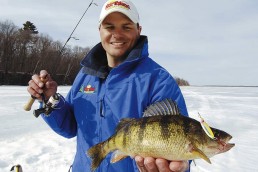Where do you Look for Early-winter Perch?
SHARE THIS POST
Early in the ice fishing season, most perch anglers start out on shoreline-connected structure because of the thin ice conditions. Once there is more ice on the lakes, anglers can begin searching for perch in deeper water and on mid-lake structure. Small lakes seldom provide everything perch need to grow to jumbo size. When something essential is missing in a lake, it limits the growth potential of the perch, and usually results in a stunted perch population.
The best perch lakes are usually larger lakes that are at least a few thousand acres or more in size. The lakes have to have plenty of “perch-friendly” food during all four seasons of the year for them to thrive. This usually means multiple-shoreline-connected flats and several larger mid-lake humps and bars with the right depth on top. The lakes also need several large basin areas full of nymphs and aquatic insects for perch to feed on during the winter.
Perch also need substantial amounts of standing weeds to lay their eggs on in the spring. If there are not enough of the right kinds of weeds, the perch population will suffer. A strong perch population depends on having huge numbers of them hatching every spring, with strong-age year-classes of perch nearly every year.
These fish have a limited life span, regardless of where they live. Only a small fraction of the perch population grows fish older than 10 years, so perch need to grow fast to reach jumbo size. They do have high rates of attrition, but a healthier perch population can provide good forage for just about everything else in the lake year ‘round.
Perch are feeding machines and will pillage and plunder their way across the shallow flats like an invading hoard, devouring whatever forage they can find. The typical diet includes a variety of minnows and smaller fish, along with aquatic insects, freshwater shrimp, crayfish and young-of-the-year perch. They like to feed on both shallow and deep flats, depending on what type of forage they’re targeting. Most good perch lakes have both shallow and deep patterns for this species most of the winter.
At first glance, most shallow flats may look like a featureless desert, with no logical place for anglers to begin searching. But anglers have to resist the urge to look at the big picture too much and try looking for the smaller details.
Shoreline-connected flats go from the shore to the primary drop-off. A flat usually implies a slow taper, with the flat extending a long distance from shore before dropping into deeper water. Flats may not have a lot of obvious features, but there are usually subtle features that are formed from different types of edges. An edge is simply the area between two or more different things: an inside weedline, an outside weedline, an edge between weed types, a hole in the weeds, a finger of weeds, a patch of unusually green, healthy weeds, a heavier patch of chara-covered bottom or any patch of weeds next to rocks or some other change in the bottom type.
Are you enjoying this post?
You can be among the first to get the latest info on where to go, what to use and how to use it!
The reason edges are good places for perch to feed is they provide more than one type of habitat in a limited area. Perch feeding along edges have a better chance of finding something to eat and also have the opportunity to find a greater variety of forage.
The main focus of most perch is food and safety. They want to find plenty of food, but always leave themselves an escape route if a predator shows up trying to eat them. Rises on the flats, depressions in the flats, and other features like old river channels, can all be important keys to finding perch. They want to be able to dive into a depression or hole on the flat, hide in some thicker patch of weeds, drop between some big rocks or swim off the side of the flat into deeper water when they get spooked or when they are done feeding.
Once anglers find some good locations that provide all of things needed, the same areas will likely be good year after year, unless the area gets too much fishing pressure. Weather conditions can also have a dramatic effect. Perch usually like to feed in full sun rather than shade because the larger predators come out to play under low-light conditions.
I’ll use my Humminbird Ice Helix 7 to check out spots from previous winters or spots that I have marked on GPS during the summer when I began searching for perch. I like to go light early in the season, so I use an electric drill with a 6-inch Nils auger bit to drill my holes. There is no need to drill as many holes as some do when searching. Perch are curious and can see your bait from a distance. When in doubt, I use my Aqua-Vu Micro 5 to put down the holes and check all around a hole for the larger fish.
The trick is to catch a few keeper perch so you know they are in the area. Then, anglers can drill a few more holes to try and figure out where the rest of the school is located.
Finally, speed is another important aspect. The longer it takes you to get your bait back down the hole when you are on fish, the fewer fish you are going to catch.
MWO
SHARE THIS POST
Did you enjoy this post?
You can be among the first to get the latest info on where to go, what to use and how to use it!
Brian 'Bro' Brosdahl
Outdoor communicator Brian “Bro” Brosdahl lives in northern Minnesota. He is a walleye guide in the Cass Lake, Leech Lake and Lake Winnibigoshish areas. He is sponsored by Northland Fishing Tackle, Frabill/Plano, Aqua-Vu, Humminbird/Minn Kota, St. Croix Rods, Ranger Boats, and Evinrude. Guide inquiries: brosguideservice.com. Follow on social media.


